![]()
![]()
![]()
Use LEFT and RIGHT arrow keys to navigate between flashcards;
Use UP and DOWN arrow keys to flip the card;
H to show hint;
A reads text to speech;
114 Cards in this Set
- Front
- Back
|
What is a Vector Quantity? |
Vector Quantities have a Magnitude and a Direction. Vectors are Represented by an Arrow - the Length of the Arrow Shows the Magnitude, and the Direction of the Arrow Shows the Direction of the Quantity. |
|
|
Give Some Examples of Vector Quantities |
Force
Velocity
Displacement
Acceleration
Momentum Weight |
|
|
What are Scalar Quantities? |
Scalar Quantities Only have Magnitude and NO Direction |
|
|
Give Some Examples of Scalar Quantities |
Speed
Distance
Mass
Temperature
Time Energy |
|
|
What is the Difference between Distance and Displacement? |
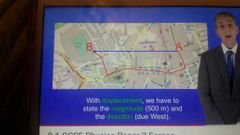
Distance is a Scalar Quantity. It Gives us no Idea About Direction. Displacement is a Vector Quantity. Displacement is Distance in a Specific Direction. Displacement = Blue Vector = Red |
|
|
What is a Force? |
A Force is a Push or a Pull on an Object that is Caused by it Interacting with Something.
All Forces are Either Contact or Non-Contact Forces The Unit of Forces = Newton's (N) |
|
|
What is a Contact Force? Give Some Examples |
A Contact Force is When 2 Objects Have to be Touching for a Force to Act. (Physically Touching)
E.g. Friction
Air Resistance
Tension in Ropes
Normal Contact Force - Only Happens when 2 Objects are in Direct Contact |
|
|
What is a Non-Contact Force? |
A Non-Contact Force is When Objects Don't Need to be Touching for a Force to Act. (Physically Separated)
E.g. Magnetic Force
Gravitational Force
Electrostatic Force (Between 2 Charged Objects) |
|
|
What is the Gravitational Field Strength? |
The Gravitational Field Strength is a Measure of the Force of Gravity in a Particular Location. Gravitation Field Strength Varies with Location. Objects on the Surface of the Earth Experience a Force of 9.8N for Every Kg of their Mass. |
|
|
What is Mass? |
The Mass of an Object Tells us How Much Matter the Object has in it. The Mass of an Object Does Not Depend on where the Object is. Unit of Mass = Kilogram You can Measure Mass Using a Mass Balance. Mass is a Scalar Quantity because it has NO Direction. |
|
|
What is Weight? |
The Weight of an Object is the Force Acting on it Due to Gravity. The Weight of an Object Depends on the Gravitational Field Strength at the Location of an object. Unit of Weight = Newton (N) You can Measure Weight Using a Newtonmeter/ Calibrated Spring Balance. E.g. an Object has the Same Mass whether it's on Earth or the Moon - but it's Weight will be Different. The Weight of an Object (Force due to Gravity) can be Considered to Act at a Single Point. Scientists Call this the Centre of Mass. |
|
|
What is the Centre of Mass? |
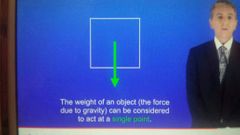
The Weight of an Object (Force due to Gravity) can be Considered to Act at a Single Point. Scientists Call this the Centre of Mass. |
|
|
What is the Formula that Links Weight, Mass and Gravitational Field Strength? |
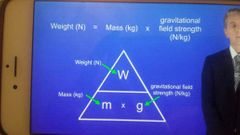
The Weight of an Object is Directly Proportional to the Mass. If we Double the Mass then the Weight Also Doubles. |
|
|
What is the Resultant Force? |
When Several Forces act on an Object, they could be Replaced by a Single Force which has the Same Effect. The Resultant Force is a Single Force that has the Same Effect as All of the Original Forces Acting Together. It is the Overall Force.
To Work out the Resultant Force: Large Force - Smaller Force. |
|
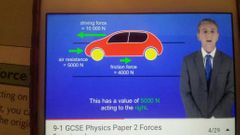
Calculate the Resultant Force: |
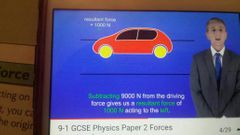
5000N + 4000N = 9000N 9000N - 10,000N = 1000N |
|
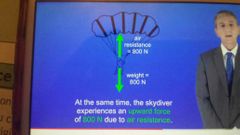
Calculate the Resultant Force: |
The Forces are Balanced - There is No Overall Force. The Resultant Force is Zero. |
|
|
Draw the Free Body Diagram of an Aeroplane Flying at a Constant Velocity at a Constant Altitude |
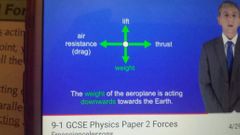
Constant = Opposite Forces Balance Length of Arrow = Size of Force Direction of Arrow = Direction of Force |
|
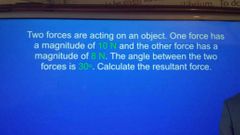
Draw the Vector Diagram: 1cm = 1N |
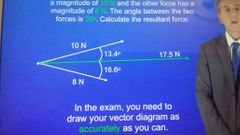
1) Use a Ruler, Protractor To Draw the 2 Forces. 2) Then Draw a Parallelogram. Copy the 8cm Line at the Head of the 10cm Force Vector. Use a Protractor to make sure that the Angle is still 30°. 3) Then Connect the Last Line - 10cm line to the Head of the 8cm Force Vector. 4) Then Draw a Straight Line Through the Tails/Ends of the Force Vectors and Measure the Length using a Ruler. Then Calculate the Resultant Force it Represents |
|
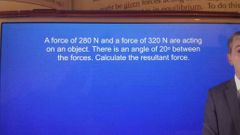
Draw this Vector Diagram: Scale: 1cm = 40N |

1cm = 40N so the Resultant Force is 592N. |
|
|
Describe How you Could a Resolve a Single Force into 2 Forces |

Diagonal Forces Can be Split into 2 Components at Right Angles to Each Other. ( Horizontal and Vertical) You can Resolve a Force (Split it into Components) by Drawing it on a Scale Grid. |
|
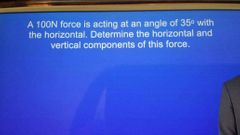
Draw the Resolving Force: Scale : 1cm = 10N RUB OUT ANY FAINT LINES SO THAT YOU ONLY SHOW THE VECTORS IN YOUR ANSWER |
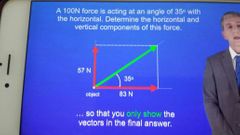
1) Draw Faint Lines to Show the Horizontal and Vertical Axes. 2) Use a Protractor to Measure 35° from Horizontal. Then Draw the 100N Vector Force using a Ruler. 3) Then Draw Dotted Lines from the Head of the Vector to the Horizontal + Vertical Axes. Then Draw the Horizontal and Vertical Components (RED). 4) Then Use a Ruler to Determine the Magnitude. |
|
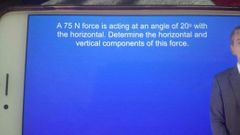
Draw the Resolving Force Scale : 1cm = 10N |
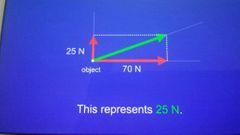
|
|
|
What is the Formula for Work Done? |
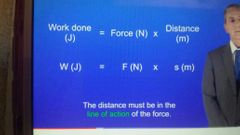
1 Joule = 1Nm |
|
|
What is Work Done = ? |
Work Done = Energy Transferred |
|

Describe the Energy Transfers that Take Place when a Man Pushes a Box Along the Floor |
The Man is Applying a Forward Force to the Box. However the Force of Friction is Acting Between the Bottom of the Box and the Floor. This Friction Causes the Temperature of the Box to Increase. The Chemical Energy Store in the Man's Muscles has been Transferred to the Thermal Energy Store of the Box. |
|
|
How do we Stretch, Compress or Bend an Object? |
In Order to Change an Object's Length or Shape, then we Have to Apply More than 1 Force - Otherwise the Object Would Simply Move in the Direction of the Applied Force, Instead of Changing Shape. |
|
|
What is the Difference Between an Elastic Object and an inelastic Object? |
Elastic Objects are Objects that can be Elastically Deformed. An Object's has been Elastically Deformed if it can Go Back to its Original Shape and Length after the Force has been Removed. This is Called Elastic Deformation. When we Stretch Inelastic Objects (e.g. Polymers), they DO NOT Return to their Original Shape and Length after the Force has been Removed. This is Called Inelastic Deformation. |
|
|
What is the Formula To Calculate the Force Needed to Stretch an Object? |

We Can Also Use the Equation to Calculate the Compression When an Object is Squeezed.
Replace Extension with Compression.
Extension is Directly Proportional to Force, provided that the Limit of Proportionality is Not Exceeded |
|
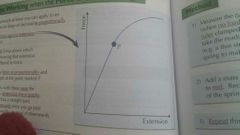
What is the Limit of Proportionality ? |
When the Line of Best fit is a Straight Line it means there is a Linear Relationship between Force and Extension (they're Directly Proportional). F=KE so the Gradient of the Straight Line is K (Spring Constant).
However, if we Add Too Much Force to the Spring, then the Graph Curves and Becomes Non-Linear. By Overstretching the Spring, we have Exceeded the Limit of Proportionality and now Extension is No Longer Proportional to Force.
The Limit of Proportionality = P |
|
|
Write a Method On How to Investigate the Relationship Between Force and Extension for a Spring
REQUIRED PRACTICAL 6 |
1) Set up the Apparatus as Shown in the Diagram. Don't Add Any Weights Yet.
2) Measure the Natural Length of the Spring (when no Load is Applied) with a Millimeter Ruler Clamped to the Stand. The Top of the Spring must be at the 0 Point on the Ruler.
Make sure you Take the Reading at Eye Level and Add a Marker (thin Strip of Tape) to the Bottom of the Spring to make the Reading More Accurate.
3) Then Add a Mass to the Spring and Allow the Spring to Come to Rest. Record the Mass and Measure the New Length of the Spring.
The Extension is the Change in Length (from unstretched spring).
4) Repeat this Process until you have Enough Measurements (No Fewer than 6). 5) Then Plot Your Results on a Force-Extension Graph. |
|
|
How Do you Calculate Work Done in Stretching a Spring? |
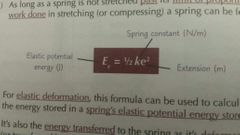
|
|
|
What is a Moment? |
A Force or a System of Forces may Cause an Object to Rotate. A Moment is the Turning Effect of a Force. |
|
|
What is the Unit for Moment? |
Moment (Nm) = Newton-metre |
|
|
What is the Equation to Calculate Moments? |
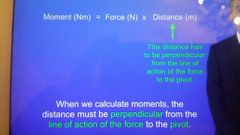
The Distance Must be Perpendicular (at Right Angles) from the Line of Action of the Force to the Pivot. |
|

Calculate the Moment |
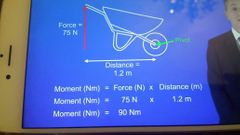
|
|
|
What is the Equation for the Moment of a Balanced Object? |
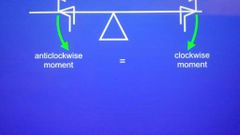
|
|
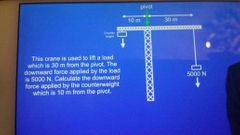
Calculate the Moment of This Balanced Object |
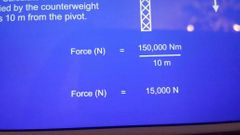
|
|
|
Use Moments to Describe Why Unbalanced Objects Topple |
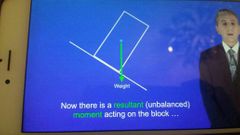
The Weight of an Object Acts Directly Down from the Centre of Mass. When we Tilt the Block, there Comes a Point Where the Line of Action of the Weight lies Outside the Base of the Object. This Causes a Resultant (Unbalanced) Moment to Act on the Block can Cause it to Topple. |
|
|
Give Some Examples of Moments |
Wheelbarrow Spanner Seasaw Crane Hammer Used to Remove Nails |
|
|
Describe How a Lever can be Used to Transmit the Rotational Effect of Forces |
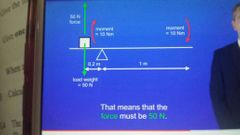
Levers are Force Multipliers. They Increase the Distance from the Pivot and Allow us to Lift a Heavy Object by applying a Relatively Small Amount of Force. |
|
|
Give Some Examples of Simple Levers |
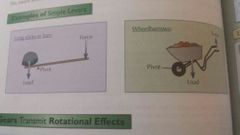
Wheelbarrows Long Sticks/Bars |
|

Describe How Gears Can Transmit (Pass on) the Turning Effect of a Force UNFINISHED |
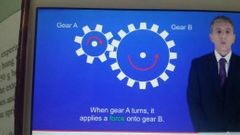
Gear A is Connected Directly to the Turning Force of the Engine. Gear B is Connected to the Wheels. This Gear System will Transmit the Rotational Effect of a Force (Turning Force) from the One Place (Engine) to Another (Wheels). When Gear A Turns, it Applies a Force onto Gear B, Causing it to Turn in the Opposite Direction. The Turning Effect Depends on the Distance Between the Edge of the Gear and the Centre. Because Gear B has Twice the Radius of Gear A, the Turning Effect of Gear B is Twice as Large. This Means that the Turning Effect of the Engine has been Doubled as it is Transmitted to the Wheels. Gear A Rotates Twice Every Time Gear B Rotates Once so the Work Done of the 2 Gears is the Same. |
|
|
What are Fluids? |
Fluids are Gases and Liquids - their particles are able to move around and flow |
|
|
What is the Equation to Calculate the Pressure at the Solid Surface of a Fluid? |

P = F ÷ A
Unit of Pressure = Pa |
|
|
Explain Why Atmospheric Pressure Decreases with an Increase in Height |
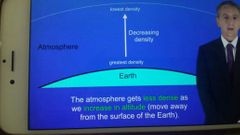
The Atmosphere is Most Dense at the Surface of the Earth. So at the Earth's Surface, there are the Greatest Number of Air Molecules in a Given Volume.
The Atmosphere gets Less Dense as we Increase in Altitude (move away from the surface of Earth).
The Pressure of the Atmosphere is Cause by Air Molecules Colliding with a Surface. As the Surface Increases Height above Ground Level, the Number of Air Molecules Above the Surface Decreases.
This Means that Atmospheric Pressure Decreases with an Increase in Height. |
|
|
What is Atmospheric Pressure? |
Atmospheric Pressure is Created on a Surface by Air Molecules Colliding with the Surface. |
|
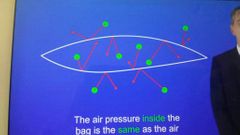
Describe Why Bags Inflate on Aeroplanes? |
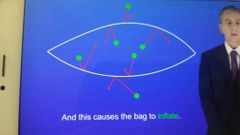
At ground Level, the Air Pressure inside the Bag is the Same as the Air Pressure Outside the Bag. When Aeroplanes are Flying, the Air Pressure in the Cabin is Kept at a Slightly Lower Level than the Air Pressure on the Ground which Means that the Air Pressure Inside the Bag is Now Greater than the Air Pressure in the Cabin. This Causes the Bag to Inflate. |
|
|
What Does the Pressure in a Liquid Depend On? |
The Pressure in a Liquid Depends on Depth (Distance from top to bottom) and Density (how close together particles are).
The Pressure of a Liquid Increases With Depth. This is Because as the Depth Increases, there is a Greater Weight of Liquid Acting Downwards so the Pressure is Higher.
The Pressure of a Liquid Also Increases with the Density of the Liquid. Liquids with a Greater Density have a Greater Weight Acting Downwards so the Pressure is Higher. |
|
|
What is the Equation to Calculate the Pressure in a Liquid? |
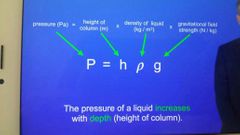
Height of Column = Depth |
|
|
Describe How Objects in Fluids Experience Upthrust |
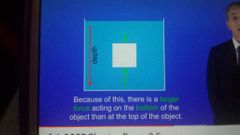
The Pressure of a Liquid Depends on the Depth. When an Object is Submerged in a Fluid, the Bottom of the Object is at a Greater Depth than the Top of the Object so Experience a Larger Pressure than the Top. Because of this, there is a Larger Force Acting on the Bottom of the Object than at the Top. So There is a Resultant Force Acting Upwards, Known as Upthrust. |
|
|
When can An Object Float in a Fluid? |
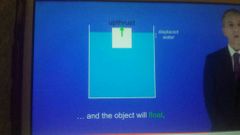
An Object Floats if it's Weight = Upthrust. If the Upthrust is Less than the Object's Weight, the Object Sinks. If an Object's Weight is More than the Upthrust, the Object Sinks. When an Object is Placed in Water, the Size of the Upthrust Acting on the Object is the Same as the Weight of Water Displaced by the Object. SO If an Object can Displace it's Own Weight of Water then the Upthrust Will be Equal to the Object's Weight and the Object will Float. |
|
|
Describe How Submarines Make Use of Upthrust to Sink and Float |
Submarines Make Use of Upthrust. To Sink, Tanks are Filled with Water to Increase the Weight of the Submarine so that it is More than the Upthrust. To Rise to the Surface, the Tanks are Filled with Compressed Air to Reduce the Weight so that it's Less than the Upthrust. |
|
|
Describe the Difference between Distance and Displacement |

Distance is a Scalar Quantity. It just tells us How Far an Object Moves - Magnitude (NO DIRECTION) Displacement is a Vector Quantity. It tells us the Distance an Object Moves in a Straight Line from the Start Point to the Finish Point. It has Magnitude and Direction. |
|
|
What is the Equation for Speed? |
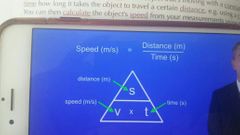
Speed is Scalar. It has No Direction. |
|
|
What is the Typical Speed for a Person Walking? |
Normal Walking Speed = 1.5m/s |
|
|
What is the Typical Speed for a Person Running? |
Running Speed = 3m/s |
|
|
What is the Typical Speed for a Person Cycling? |
Cycling Speed = 6m/s |
|
|
What are the Factors that Affect the Speed at which a Person Walks, Runs or Cycles? |
The Factors that Affect the Speed at which a Person can Walk, Run or Cycle: - Fitness - Age - Distance Travelled - Terrain (e.g road, field) A Younger, Fitter People Would be able to Achieve a Faster Speed than an Older, Unfit Person Speed also Depends on Terrain e.g. People Move more Rapidly on Flat Ground Rather than Uphill. |
|
|
What is the Typical Speed for a Car on a Main Road? |
Car on Main Road = 13m/s
Car on Motorway = 25m/s - 30m/s |
|
|
What is the Typical Speed for a Train? |
Fast Train in UK = 50m/s |
|
|
What is the Typical Speed for a Plane? |
Aeroplane = 250m/s |
|
|
What is the Speed of Sound in Air? |
Speed of Sound in Air = 330m/s The Speed of Sound in Air Varies. E.g. Sound Travels Faster on Warmer Days. |
|
|
What is Velocity? |

Velocity is Speed in a Given Direction. We Calculate the Velocity Using the Speed Equation. With Velocity, we State Both Magnitude + Direction. |
|
|
Describe How Objects that are Travelling at a Constant Speed can have a Changing Velocity |
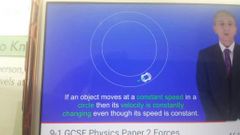
An Object Moving in a Circle at a Constant Speed has a Constantly Changing Velocity as the Direction is Always Changing. This also Includes Objects Travelling Around Part of a Circle e g Moving around a Corner |
|
|
When can an Object's Distance be Plotted on a Distance-Time Graph? |
If an Object Moves in a Straight Line, it's Distance Travelled can be Plotted on a Distance-Time Graph. |
|
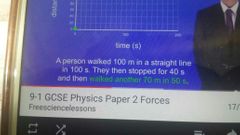
Construct a Distance-Time Graph: |
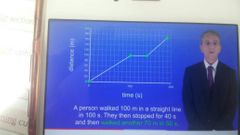
|
|

Describe How the Shape of a Distance-Time Graph Tells us How an Object is Moving |
Gradient = Speed
Flat Lines = Stationary
Straight Lines Uphill = Constant Speed
Curves = Acceleration or Deceleration
|
|
|
How Do We Calculate Speed on a Distance-Time Graph? |
Speed = Gradient |
|
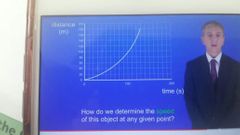
How Do we Determine the Speed of an Object that is Constantly Accelerating? DISTANCE-TIME GRAPH |
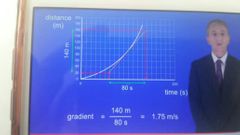
If we Wanted the Know the Speed of an Object at e.g. 100s We Draw a Tangent then Work out the Gradient |
|
|
What is Acceleration? |
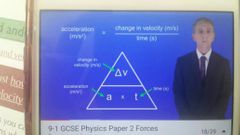
Acceleration is Change in Velocity in a Certain Amount of Time.
V-U ÷ T = Final V - Initial V ÷ T Deceleration = - Acceleration (negative) |
|
|
When Do We Draw Velocity-Time Graphs? |
When an Object's Velocity Changes |
|
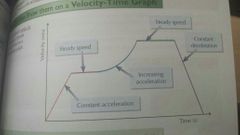
What Does a Velocity-Time Graph Tell Us? |
Gradient = Acceleration Flat Lines = Constant Acceleration Steep Lines = The Greater the Acceleration/Deceleration Area Under Graph = Distance |
|
|
How Do We Calculate Acceleration on a Velocity-Time Graph? |
Acceleration = Gradient |
|
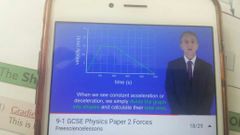
How Do we Calculate Distance on a Velocity-Time Graph? For Regular Shapes (Constant Acceleration): |

Divide Graph into Shapes (Triangles, Rectangles) Calculate Their Area |
|

How Do We Calculate Distance on Velocity-Time Graphs? For Irregular Graphs? (Curves) |
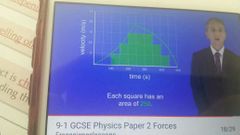
Count Squares Under Line + Estimate the Total of the Incomplete Squares e.g 20 Multiply This Number by the Area of 1 Square e.g. 250 20 × 250 = 5000m = Distance |
|
|
How Do We Calculate Constant/Uniform Acceleration? GIVEN EQUATION |
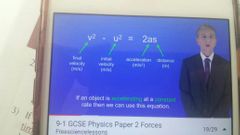
|
|
|
What is the Acceleration of an Object Falling Towards Earth? E.g. Skydiver |
When an Object Falls Towards the Surface of the Earth, it initially Accelerates at Around 9.8m/s^2 This Objects Accelerates Due to the Force of Gravity. |
|
|
What is Friction? What is Drag and Air Resistance? |
Friction Acts in the Opposite Direction to Movement. You get Friction Between 2 Surfaces in Contact, or when an Object Passes through a Fluid (Drag). Drag is the Resistance you get in a Fluid (gas or Liquid). Air Resistance is a Type of Drag - it's the Frictional force of Air Acting on a Moving Object. |
|
|
How Can You Reduce Drag and How Does it Increase? |
You can Reduce Drag by Making the Object Streamlined e.g. Car. Drag Increases as Speed Increases - When a Car Speeds up, the Frictional Forces Increase. |
|
|
What is Terminal Velocity? |
When an Object Falls to Earth, it initially Accelerates at Around 9.8m/s^2. This is because the Force of Gravity is Much more than the Air Resistance (frictional Force) slowing The Object down.
As the Speed Increases the Friction Builds up. This Reduces the Acceleration until Eventually the Force of Gravity = the Force of Air Resistance. (Resultant Force is 0)
At this Point, the Object Stops Accelerating (reaches its maximum speed) and Moves at a Constant Velocity called the Terminal Velocity.
Terminal Velocity Applies to all Objects Falling through Fluids e.g.(air, water) |
|
|
What Affects the Terminal Velocity? |
Terminal Velocity Depends on Shape and Area. Some Objects Experience a Greater Force of Friction due to Their Shape (parachute) so they will have a Lower Terminal Velocity as More Air Resistance Acts on them. E.g. an Open Parachute has More Air Resistance = Lower Terminal Velocity. A Closed Parachute has a Small Area for Air Resistance = Higher Terminal Velocity |
|
|
What is Newton's 1st Law of Motion? |
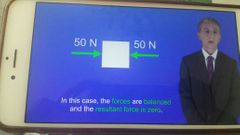
If the Resultant Force on a Stationary Object is 0, the Object will Remain Stationary.
If the Resultant Force on a Moving Object Is 0, then the Object will Continue Moving in the Same Direction at the Same Speed (Same Velocity). 0 Resultant Force = Balanced Forces |
|
|
What Effect Does a Resultant Force have on an Object? |

An Overall Resultant Force (NOT 0) causes an Object's Speed and Direction to Change. A Greater Driving Force causes an Object to Accelerate. A Resultant Force Acting on the Bottom of an Object causes the Object to Accelerate Upwards. |
|
|
What is Newton's 2nd Law of Motion? |
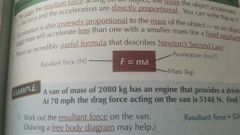
The Acceleration of an Object is Directly Proportional to Resultant Force. Acceleration is Inversely Proportional to Mass. |
|
|
Estimate the Speed, Acceleration and Force Involved in a Car Moving on a Main Road (13m/s) to a Motorway (30m/s) |
Cars Travel at 13m/s on a Main Road and 30m/s on a Motorway. To Accelerate from a Main Road to a Motorway Involves a Typical Acceleration of 2m/s^2. For a Typical Car, that Would Require a Force of 2000N. |
|
|
What is Inertia? Refer back to Newton's 1st Law |
So Objects will Stay Still/Stationary or Continue in the Same State of Motion Until a Resultant Force is Applied. (Newton's 1st Law)
This Tendency to Continue in the Same State of Motion = Inertia |
|
|
What is Inertial Mass? Refer back to Newton's 2nd Law |
Inertial Mass is a Measure of How Difficult it is to Change the Velocity of an Object. Inertial Mass = Ratio of Force over Acceleration = m = F ÷ A (2nd Law) E.g. an Object with a Large Inertial Mass will Require a Larger Force to Produce a Given Acceleration. |
|
|
What is Newton's 3rd Law of Motion? |
When 2 Objects Interact, the Forces They Exert on Each Other are Equal and Opposite. |
|
|
Give an Example of Newton's 3rd Law e.g. Car |
When a Car is Driving, the Wheel Exerts a Force in the Opposite Direction on the Road.
At the Same Time the Road Exerts a Force in the Forward Direction on the Wheel. These 2 Forces are Equal in Magnitude but Opposite in Direction. |
|
|
Give an Example of Newton's 3rd Law e.g. Pushing a Wall |

When a Person Pushes a Wall, the Wall Exerts a Normal Contact Force Which Acts Back on Him. These 2 Forces are Equal in Magnitude but Opposite in Direction. |
|
|
Give an Example of Newton's 3rd Law e.g Rocket |
When a Rocket Fires, there is a Downward Push Force on the Exhaust Gases. The Exhaust Gases Exert an Equal Force Upwards on the Rocket. These 2 Forces are Equal in Magnitude but Opposite in Direction. |
|
|
Describe the Forces Acting on a Skydiver VID 23 UNFINISHED |
P |
|
|
Write a Method to Investigate How Force Affects Acceleration
REQUIRED PRACTICAL 7 |
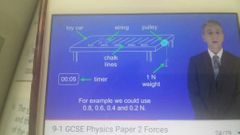
1) Set up the Apparatus as Shown in the Diagram. Connect a Toy Car/Trolley to a Piece of String that Goes over a Pulley and is Connected on the Other Side to a 1N Weight.
On the Desk, Draw Chalk Lines at Equal Space e.g. Every 10cm
2) Hold the Car at the Starting point (0cm) and Let go when Ready. Because there is a Resultant Force Acting through the String, the Car will Accelerate along the Bench.
3) Record the Time that the Car Passes each Distance Marker with with a Stopwatch.
4) Then Repeat the Experiment Several Times and Decrease the Weight Each Time e.g. 0.8N, 0.6N, 0.4N and 0.2N.
Newton's 2nd Law Tells us that Acceleration is Directly Proportional to Force so the Acceleration of the Toy Car Is Proportional to Weight. So Increasing Weight increases Acceleration |
|
|
How Can We Record the Time that the Car Passes each Distance Marker More Accurately? REQUIRED PRACTICAL 7 |
if the Car is Moving Rapidly, then it will be Difficult to Record an Accurate Time. Improvement: Record the Experiment on a Phone and Play the Video Back to Record the Accurate Times. |
|
|
Write a Method to Investigate How Mass Affects Acceleration |
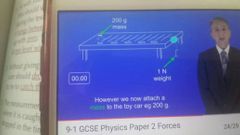
1) Set up the Apparatus as Shown in the Diagram. Attach a Mass to the Toy Car e.g. 200g and Connect it to a Piece of String that Goes a Pulley and is Connected on the Other Side to a 1N Weight. Keep the Force Constant e.g. 1N.
2) On the Desk, Draw Chalk Lines at Equal Space e.g. Every 10cm
2) Hold the Car at the Starting point (0cm) and Let go when Ready. Because there is a Resultant Force Acting through the String, the Car will Accelerate along the Bench.
4) Record the Time that the Car Passes each Distance Marker with with a Stopwatch.
4) Then Repeat the Experiment Several Times and Increase the Mass Attached to the Toy Car.
Newton's 2nd Law Tells us that Acceleration is Inversely Proportional to Mass so as we Increase the Mass of the Car, the Acceleration Decreases. |
|
|
How Can you Calculate the Distance of Stopping a Car in an Emergency? |
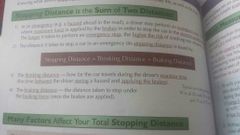
Thinking Distance: How Far the Car Travels During the Drivers Reaction Time (the Time Between the Driver seeing a Hazard and Applying the Brakes). Braking Distance: The Distance Taken to Stop under the Braking Force (once the Brakes are Applied). |
|
|
How Can You Measure Reaction Time? - Ruler Drop Test |
1) The person being tested should sit with their arm resting on the edge of a table (this should stop them moving their arm up or down during the test). 2) Hold a Ruler Vertically between their Thumb and Forefinger. Make sure that the 0 End of the ruler is Level with their Thumb and Finger. Then Let Go without giving any Warning. 3) The person being tested should try to Catch the Ruler as quickly as they can. 4) Reaction Time is measured by the Number on the Ruler where it's Caught. The number should be read from the Top of the Thumb. The Further down the Ruler it's caught ( the higher the number), the Slower their Reaction Time. 5) Repeat the Test Several times then calculate the Mean Distance the ruler fell. |
|
|
What are the Factors that Affect Thinking Distance? |
1) Your Speed - the Faster you're Going the Further you'll Travel During the Time you take to React. 2) Your Reaction Time: The Longer your Reaction Time, the Longer Your Thinking Distance. This can be Affected by Tiredness, Drugs or Alcohol. Distractions can Affect your Ability to React. |
|
|
What are the Factors that Affect your Braking Distance? |
Speed - the Faster a Vehicle, the Longer it takes to Stop. Wet or Icy Conditions Reduce the Friction between the Tyres and the Road and Increase the Braking Distance. If a Car Has Worn Tyres, the Braking Distance can Also Increase. Worn Brakes also Increase Braking Distance. |
|
|
Describe the Energy Changes that Take place when a Vehicle Brakes |
During Braking, the Brake Presses Against the Wheel which Causes Friction.
This Causes the Kinetic Energy of the Car to be Converted to Thermal Energy in the Brakes. This causes the Temperature of the Brakes to Increase. At the Same Time, the Car Loses Kinetic Energy and Slows Down.
The Greater the Speed, the Greater the Braking Force Needed to Stop the Car in a Certain Distance.
A Larger Braking Force will Cause the Car to Decelerate Rapidly (large Deceleration) |
|
|
Describe the Dangers of Large Decelerations when a Car Breaks |
Large Decelerations can cause the Brakes to Overheat or Cause the Driver to Lose Control of the Vehicle and Skid. |
|
|
How Do you Estimate the Braking Force Required for a Vehicle to Decelerate and Stop? |
Use F=ma |
|
|
Why Must you Leave Enough Space to Stop in a Car? Why are Speed Limits Important? |
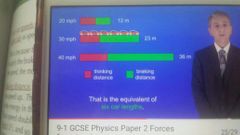
The Speed Limit in the UK is 30 mph. At this Speed, it takes a Car Around 23m to Stop which is Equal to 6 Car Lengths. So at 30mph, you Should Drive No Closer than 6/7 Car Lengths Away from the Car in Front. Speed Limits are Important because Speed Affects the Stopping Distance so Much. |
|
|
What is Momentum? |
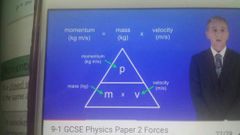
All Moving Objects have Momentum. Objects that are NOT Moving have No Momentum. Momentum is a Vector Quantity - it has Magnitude (size) and Direction. |
|
|
What is the Unit for Momentum? |
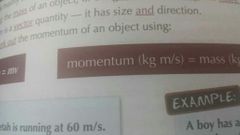
|
|
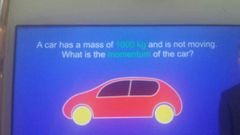
|
The Momentum = 0 The Car is Not Moving |
|
|
What is the Conservation of Momentum? |
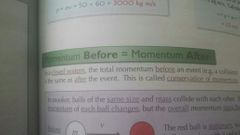
In a Closed System, the Total Momentum before an Event (collision) is Equal the Total Momentum After an Event. |
|
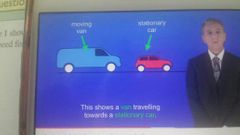
Describe How Momentum is Conserved in a Car Collision (Moving Van and Stationary Car) |
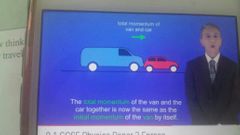
Because the Van is Moving, it has Momentum in the Forward Direction. Momentum of Van = Mass × Velocity The Stationary Car has No Momentum as it is Not Moving. When the Van Collides with the Car, they Both Move at a Lower Velocity than the Initial Velocity of the Van. The Total Momentum of Van + Car = Initial Momentum of Van by itself. Momentum is Conserved. |
|

Describe How Momentum is Conserved in a Cannon (cannon + cannonball) |
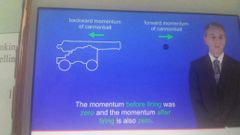
Before the Canon Fires, Total Momentum of the Cannon + Ball = 0 as they are Not Moving. When the Canon is Fired, it moves at a Large Velocity so it has Momentum in the Forward Direction. At the Same Time, the Canon Recoils (move backwards) so it has Momentum Acting in the Backwards Direction. The Total Momentum Cancels Out to 0. Momentum is Conserved. |
|
|
PRACTICE MOMENTUM QUESTIONS |
Vid 28 |
|
|
How Do you Calculate a Change in Momentum? |
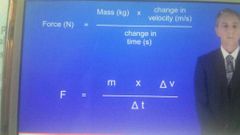
Combine F=ma Equation and Acceleration Equation A Change in Momentum is Caused by a Resultant Force Acting on an Object and Causing it to Move. |
|
|
Describe How a Rapid Change in Momentum is Dangerous |

Force = Rate of Change of Momentum
A Rapid Change in Momentum ( e.g. a car crash) Will Lead to Huge Forces Applying onto the Body and These are Extremely Dangerous and Cause Injury.
We can Reduce that Danger if the Change in Momentum Happens Over a Longer Time. The Longer Time it takes for a Change in Momentum, the Smaller the Rate of Change of Momentum and so the Smaller the Force |
|
|
Describe How Cars are Designed to Slow down Momentum Change |
Airbags Seat belts Crashmat Bike Helmet Cushioned Surface All of these Slow down Momentum Change. This Reduces the Forces Acting and Reduces the risk of Serious Injury. |
|
|
Why are Crash Tests Carried Out? |
Car Manufacturers Use Crash Tests to Design Safety Features e.g. Seatbelts. During a Car Crash, the Momentum of the Passengers Falls from a Large Amount to 0 in Less than a Second. This Places Huge Forces on the Passenger and can be Lethal. |

